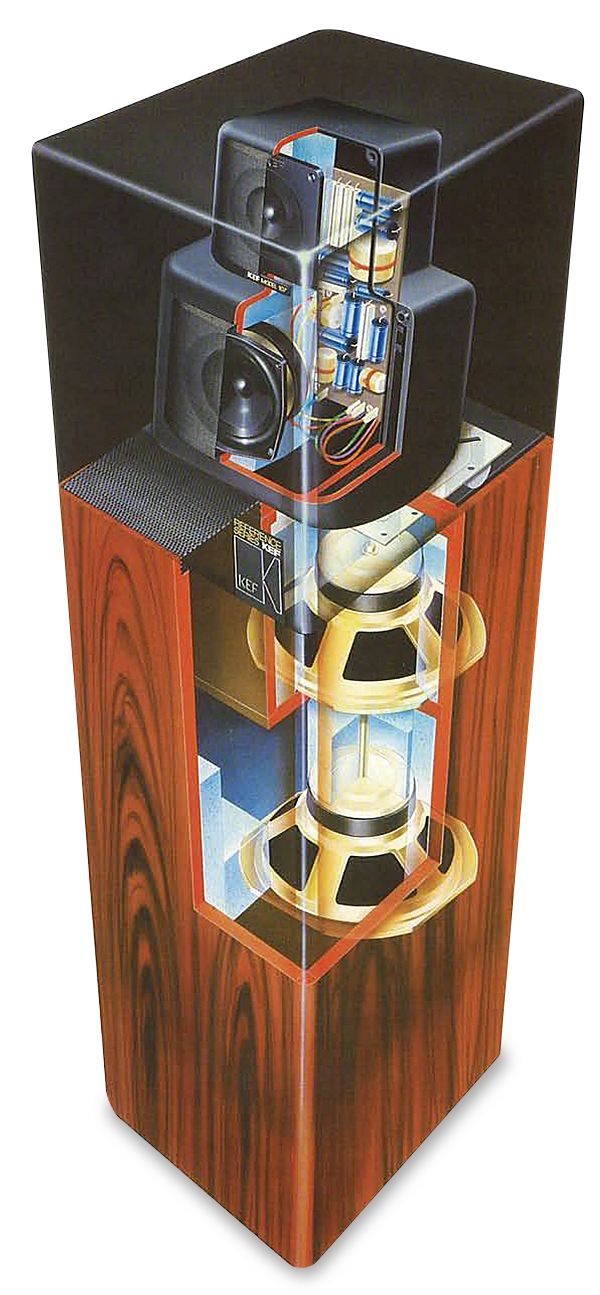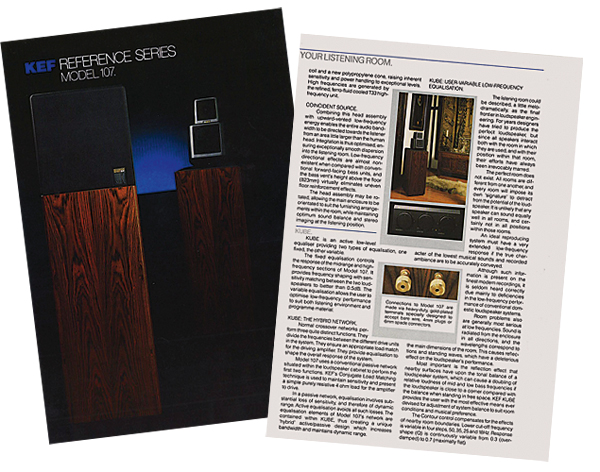A New Reference?

 John Atkinson lives with the KEF R107, its new range-topping contender
John Atkinson lives with the KEF R107, its new range-topping contender
An understated revolution in loudspeaker design has been taking place in Kent. KEF's Technical Director Laurie Fincham has put together a team of engineers who have been quietly but thoroughly examining the fundamentals of moving-coil, box loudspeaker behaviour, spinning off a regular series of products, starting with the original R105 nearly a decade ago.
Some years back, in a 1979 AES paper entitled 'A bandpass loudspeaker enclosure', Fincham outlined a strategy for a different kind of woofer loading. In 1984, the launch of the R104/2 showed what this technique could achieve.

The Equaliser
In November 1982, Laurie gave a fascinating talk to the UK AES on how low in frequency extension a loudspeaker needed to go, using a massive KEF KM1 loudspeaker equalised flat to 5Hz in order to illustrate the point. The result, surprisingly, was that differences in LF cut-offs below the nominal range of human hearing can nevertheless be distinguished subjectively.
The reason, it was suggested, is that the inevitable group delay associated with the bass high-pass filter action introduces deleterious effects much higher in frequency than the nominal cut-off point. The necessary bass equalisation used with the test loudspeaker was performed with a small box of electronics called the K-UBE, which gave control of the loudspeaker's nominal LF cut-off point and effective 'Q' of the bass tuning. By the way, K-UBE stands for 'KEF Universal Bass Equaliser'.
Technical Details
The £2000/pair R107 resembles the original R105, due to the use of a similar swivelling treble/mid 'head' unit, which connects to the bass box via a gold-plated XLR plug. The head is constructed from a honeycomb plastic material with the 8.5litre cavity filled with a mineral-loaded polymer damping 'goop'. However, whereas the 105 used a B110 driver, the R107 head uses a polypropylene cone midrange driver, coupled with a ferrofluid-cooled dome tweeter based on the R104/2's T33. The original 105 head could also be angled vertically; the R107's swivels in the horizontal plane only.
Meanwhile, the 72litre, 45kg, bass cabinet of the R107 features two 250mm paper-cone drive-units, mounted vertically in separate sealed enclosures and firing in push-pull into a cavity. The driver frames are linked by a non-magnetic tie-bar, and as the reaction motions in the frames are out of phase, they are effectively cancelled.
Boosting The Bass
The bandpass cavity communicates with the outside world via a port, with the air in the port acting as the bass driver proper, having very low mass and capable of very high excursions. In an ideal world, this will result in both high sensitivity and low distortion, coupled with smooth out-of-band behaviour.
The port itself is sited on the top of the enclosure in order to minimise room boundary effects and to position the effective bass driver very close to the midrange unit. To make the best use of the excellent woofer characteristics, the variable Q, variable roll-off, K-UBE box becomes an integral part of the R107 crossover. The 'natural' bass tuning of the R107 gives a rather high bass cut-off frequency for a box this size, –3dB around 50Hz. On the other hand, the sensitivity is high.

The roll-off slope of the bandpass enclosure is a gentle 12dB/octave, however, rather than the very steep slopes of 3rd or higher order enclosures, so it becomes a relatively simple matter to boost the bass below the cut-off frequency to give sensitivity and extension, provided the woofers are not driven beyond their mechanical limits.
To give extension down to 18Hz, a maximum 16dB of boost is required. A conventional cabinet would need to be around 500litres in volume to give the same combination of sensitivity and extension. In fact the R107 K-UBE allows the user to choose between four cut-off frequencies, which are 50Hz, 35Hz, 25Hz or 18Hz, and Q continuously variable from 0.3 (over-damped), through 0.5 (critically damped), to 0.7 (maximum extension but less good time response). There is also a bass 'contour' control to get the best match between the speaker's bass performance and the room.
The K-UBE is connected either in the amplifier's tape loop – duplicate sockets are provided – or between preamp and power amplifier, being powered from a small remote transformer, and is left on all the time. The original had flying leads but production K-UBEs will be fitted with gold-plated phono sockets so as to enable the customer to use his or her own cable.
The K-UBE must be used, as it provides some of the HF equalisation normally handled by a conventional crossover. The crossover proper incorporates 'conjugate load matching' to give a uniform, essentially resistive, 4ohm load impedance. Meanwhile the specified sensitivity is 90dB at 1m on the reference axis for 2.83V RMS band-limited (50Hz-20kHz) pink noise input under anechoic conditions.

The 4ohm impedance means that the speaker is actually drawing 2W from the amplifier for this level. Finally, signal input is via 'butch' gold-plated screw terminals found on the back of the bass bin.
![]() Sound Quality
Sound Quality
I hooked the speakers up to my Audio Research SP-10 and Krell KSA-100 combination, plugged the K-UBE in the preamp's tape loop and set the dials for maximum extension and a Q of 0.5. I then put on an LP, and winced. The sound was glassily bright, though astonishingly detailed, and had a very light bass quality, with hardly any extension.
What was going on? The answer, of course, was due to brain strain: the SP-10 was in bypass mode, which gives the most direct path from pick-up to power amplifier, but also conveniently removes the tape loop from that signal path. I was listening to the sound of the naked R107s, devoid of the civilising influence of the K-UBE equaliser at low frequencies and its response shaping at high frequencies!
























































